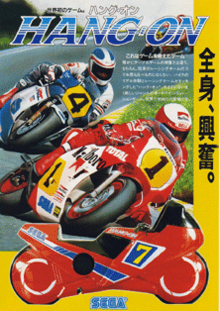
Back هانغ أون Arabic هانج اون ARZ Hang-On Catalan Hang-On German Hang-On Spanish Hang-On Finnish Hang-On (jeu vidéo) French Hang-On Italian ハングオン (ゲーム) Japanese 행온 (비디오 게임) Korean
| Hang-On | |
|---|---|
 Original arcade flyer with the deluxe arcade cabinet pictured at the bottom. | |
| Developer(s) | Sega |
| Publisher(s) | |
| Designer(s) | Yu Suzuki |
| Composer(s) | Hiroshi Kawaguchi |
| Platform(s) | Arcade, SG-1000, Master System, MSX, PC-88[7] |
| Release | |
| Genre(s) | Racing |
| Mode(s) | Single-player |
| Arcade system | Super Scaler (Sega Hang-On hardware) |
Hang-On[a] is an arcade racing game released by Sega in 1985 and later ported to the Master System. In the game, the player controls a motorcycle against time and other computer-controlled bikes. It was one of the first arcade games to use 16-bit graphics and uses the Super Scaler arcade system board, created with design input from Yu Suzuki, as technology to simulate 3D effects. The deluxe cabinet version also introduced a motion-controlled arcade cabinet, where the player's body movement on a large motorbike-shaped cabinet corresponds with the player character's movements on screen.
Yu Suzuki began development of Hang-On after deciding to design a motorcycle racing game as a way to use a torsion bar in an arcade game. With market research suggesting GP 500 racing was popular, Suzuki took inspiration from world champion Freddie Spencer and his style of racing. The game's soundtrack was written by Hiroshi Kawaguchi, who used rock music that was uncommon in arcade games at the time.
Hang-On was very popular at launch and sold well for Sega, becoming the highest-grossing arcade video game of 1985 in the United States and then the highest-grossing arcade game of 1986 in both Japan and the United States. It received a positive critical reception for its realism, graphics, bike cabinet and physical controls, though there was some initial controversy in Japan over modesty concerns involving female players with the bike cabinet. The game started the trend of "taiken" motion simulator games in the late 1980s, which Sega followed with hits such as Space Harrier (1985), Out Run (1986), and After Burner (1987); this helped the arcade video game market recover during the late 1980s. Hang-On has been recognized as a well-remembered and influential arcade game. Several sequels were later made for arcades, as well as video game consoles.
- ^ a b Cite error: The named reference
GM265was invoked but never defined (see the help page). - ^ "Hang-on (Registration Number PA0000273505)". United States Copyright Office. Retrieved 7 May 2021.
- ^ Cite error: The named reference
ATVGL:JaO1971-2005was invoked but never defined (see the help page). - ^ Cite error: The named reference
CG6was invoked but never defined (see the help page). - ^ "Overseas Readers Column: Atari Ireland Plan to Mfg. Sega's "Hang-On" for Europe" (PDF). Game Machine. No. 269. Amusement Press, Inc. 15 October 1985. p. 26.
- ^ Cite error: The named reference
hangon_saleswas invoked but never defined (see the help page). - ^ Ali, Zuhaad (7 December 2019). "Best Arcade Racing Games Of All Time, Ranked". TheGamer. Retrieved 14 February 2020.
Cite error: There are <ref group=lower-alpha> tags or {{efn}} templates on this page, but the references will not show without a {{reflist|group=lower-alpha}} template or {{notelist}} template (see the help page).